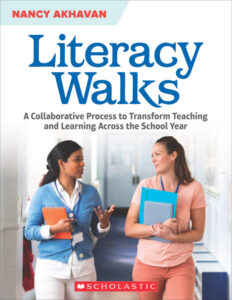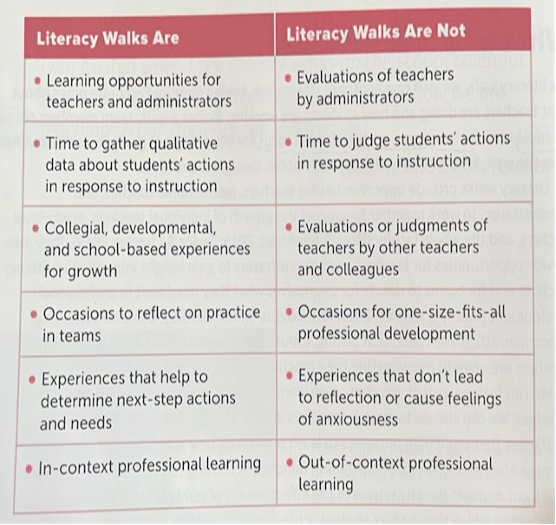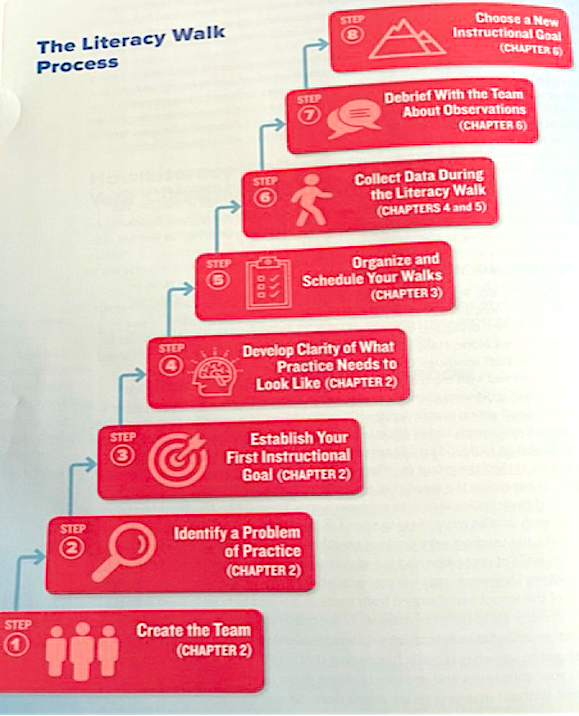Effective Literacy Walks Begin with Collaboration
Literacy Walks: A Collaborative Process to Transform Teaching and Learning Across the School Year
By Nancy Akhavan
(Scholastic, 2021 – Learn more)
Reviewed by Beth Hassinger
 Creating “Communities of Practice”
Creating “Communities of Practice”
In that time before Covid, “walk-throughs” were common practice within my building and district. A team of teachers along with building and district level administrators from across the district met to observe what was happening in classrooms at each building.
Unlike formal observations used for teacher evaluations, “walk-throughs” provided big-picture data on whether district initiatives or goals were actually being implemented in classrooms.

While the “look-fors” of these “walk-throughs” in my district were different, the goals and process were similar to those described by Nancy Akhavan in her helpful book Literacy Walks: A Collaborative Process to Transform Teaching and Learning Across the School Year.
The Rationale
Akhavan’s book is well organized and thorough in its explanation of creating a process for literacy walks. However, she is also concise, which keeps the book to what I call a “teacher manageable” ninety-three pages (without the appendix).
Chapter 1 sets the tone by giving the rationale for the importance of this work and addressing the significant questions of who, what, and why. The why has the greatest influence on all we do in education.
Literacy walks are an opportunity for collaboration. According to Akhavan, “literacy walks provide opportunities for teachers to deepen their practice by observing, listening to, and learning from colleagues.” Within this process there is the power to problem solve and to use the data collected to take ownership in new learning and next steps, as well as to ask and answer our collective questions about teaching and learning.
The table below, found on page 10, best summarizes what literacy walks are and are not.
As literacy walks are a collaborative learning experience, at the very least a school building will be involved. If this is something that your district is implementing, then members from district administration would be involved too.
Depending on the goals of the literacy walks, you may have grade level representatives as well as building administrators and support staff (instructional coaches, reading specialists, etc.). However, the goals may be focused on a reading component for every classroom in which case you might involve more grade level teachers and instructional support staff.
Walking Through the Process
Chapters 2 through 6 are focused on the steps to setting this process up. The process is fairly simple in that implementation can begin in rather short order. However, Akhavan makes sure to outline each step in great detail so participants have a complete understanding of the what, how, and why. The graphic below is found at both the inside front cover and page 14.
The Importance of Trust
The tool is only as good as the implementation, which will not be effective without trust. Akhavan addresses the importance of trust throughout the book. At step one she describes how important transparency is to building trust when creating a team. Setting norms for the collaborative conversations that will be held around goals is addressed in step three and again in debriefings at step seven. These norms are also important at the coaching level that will happen during the reflection on one goal and the preparation for the next.
The trust needed for coaching, specifically, is so important that chapter seven is devoted entirely to coaching. This chapter outlines various types of coaching as well as the “Concern-based Adoption Model.” I found this chapter to be helpful not only for the walk-through process, but just as a support for the collaboration required for working in teams. It expanded my thinking on what could be at play in the more “challenging” relationships that are likely to emerge.
The key to trust is being curious rather than judgmental (Thanks, Ted Lasso!). Akhavan explores the topic of judgment in some depth in chapter four, step six (the discussion of the data collected). There are several ways to collect data such as notes and checklists. The key to any note taking is that you are being objective. Your notes should focus on what you see so they may include things like the number of students participating or the amount of time spent on a task. This is not a place to include “conjecture or opinion[s].”
Bringing it All Together
The book concludes with many resources to support “co-coaching” conversations. Some of the tools to help support these conversations include Empathy and Benefit Maps which can be found in chapter eight. Chapter nine is a brief layout of recording what’s working as you consider the process as a whole. The forms that are referenced in this section can be found in the appendix.
While the focus of the book is creating a process for literacy walks, I do believe that the book’s many resources such as the Look-For Bank can be very helpful to any school that is looking to have literacy focused discussions. There are other resources that could prove useful when facilitating team or PLC meetings such as the Continuous Learning Cycle found on page 18.
However we might use this book, it will help us reflect on the following: “…Our instruction isn’t always great. Students don’t learn all of the time. But observation and reflection help us grow professionally and increase our efficacy” (p. 13).
Beth Hassinger works as a reading specialist at a K-5 building in a suburb north of Chicago, IL. She recently finished a second Master’s degree (in Educational Leadership) and is looking forward to a leadership position in the future. She did not read much as a child and is continually looking for ways to engage readers and invite them to see the wonder reading is. You can find her on X (formerly Twitter) @SL_Reader.

 Creating “Communities of Practice”
Creating “Communities of Practice”






























